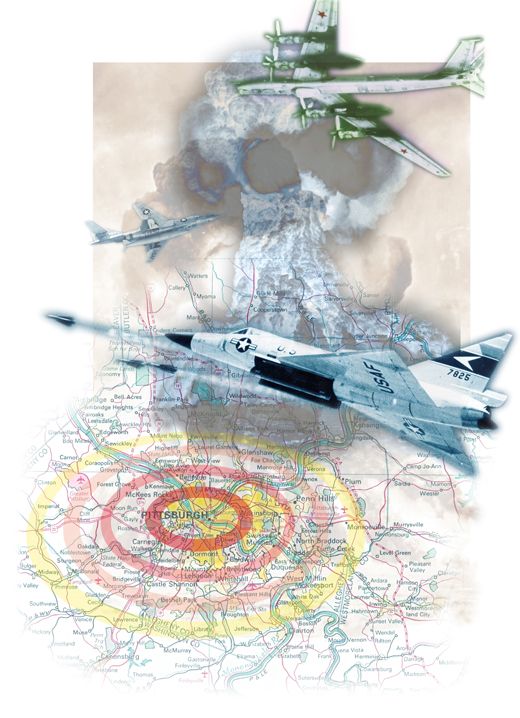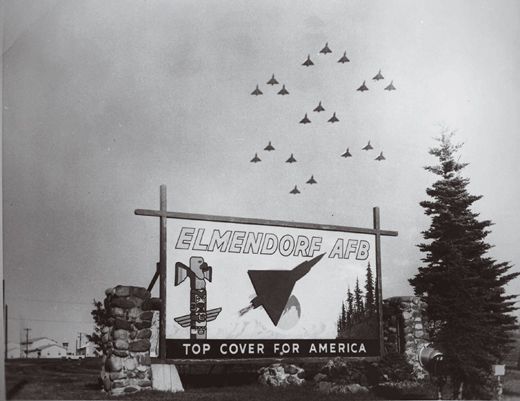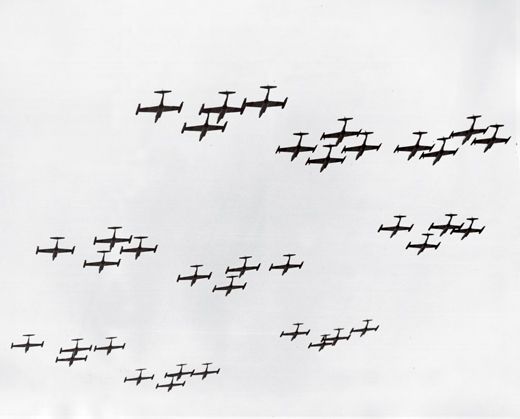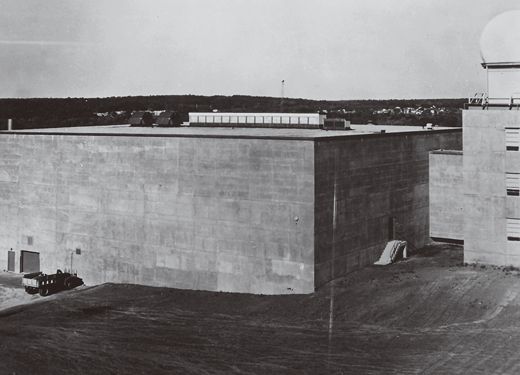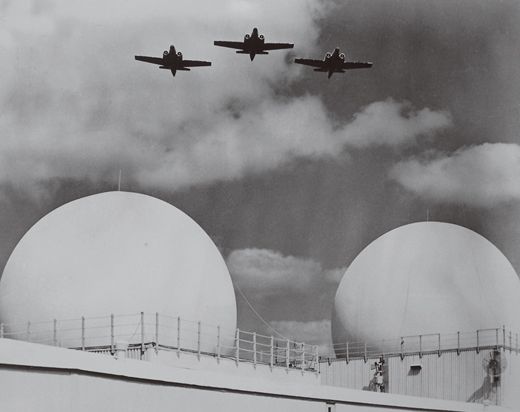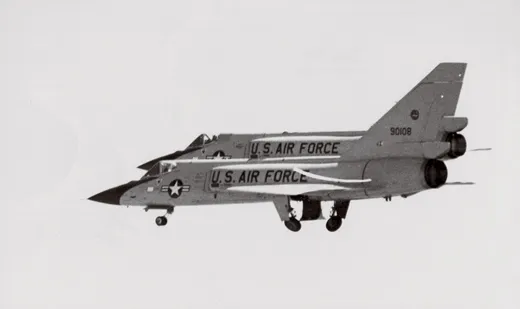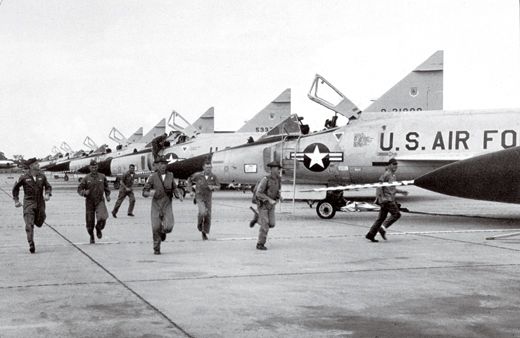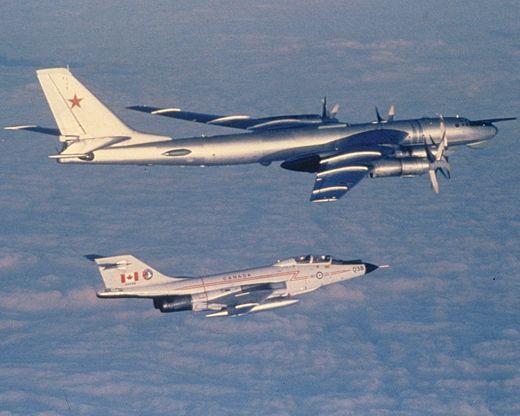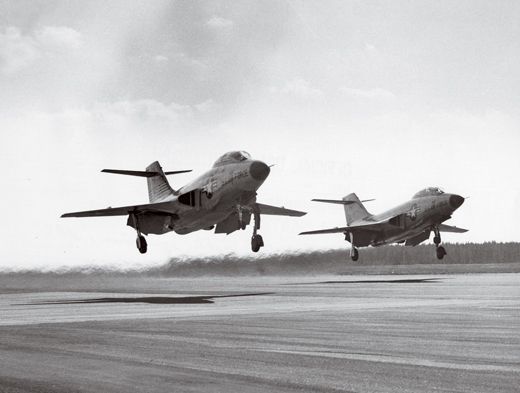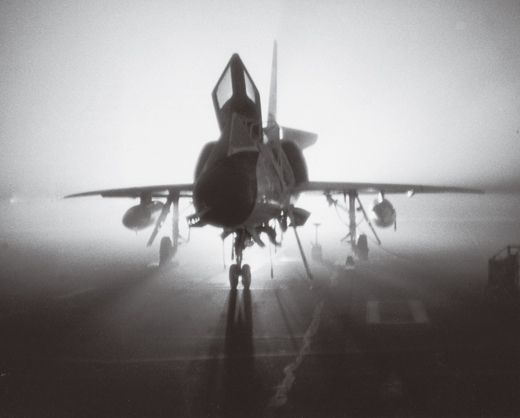The Thin Aluminum Line
Supersonic airplanes and a screen of radar stood ready during the cold war to avert the end of the world.
/https://tf-cmsv2-smithsonianmag-media.s3.amazonaws.com/filer/thin_line_631-jan07.jpg)
In the 1950s, everyone knew how the Third World War would be fought. Hundreds of Soviet bombers would sweep south across the Arctic, hauling thermonuclear loads destined for U.S. cities. The response, too, was a given. Fighters would rise to meet the intruders as they crossed into North American airspace, taking down as many bombers as possible. As the battle moved south, anti-aircraft missiles would also rise to knock out the bombers.
Some enemies would get through. Air defense, in the view of those within the newly created Strategic Air Command, was like boxing. You took a few punches, then knocked the other guy out with your own city-incinerating bombers.
To prevent this exchange, Pentagon strategists concentrated on building offensive weapons that would guarantee delivery of massive strikes. So, at the expense of fighters, SAC developed increasingly capable strategic bombers. In the early 1950s the only aircraft waiting to counter the Soviet long-range bomber fleets were the aging workhorse aircraft of the Korean War. The United States stationed a contingent of these aircraft at forward-deployed bases in Alaska.
The Lockheed F-94As and F-82 Twin Mustangs standing alert at these bases were hardly equipped for the task. “A [Soviet] Il-28 Beagle coming over, we were supposed to intercept him and force him to land by aiming a .45 pistol at him,” jokes Guy Sherrill, a retired Air Force colonel who flew F-94s from Galena and King Salmon airbases in 1953.
Sherrill had been chosen to train on a new all-weather jet interceptor, Northrop Grumman’s F-89, a big, straight-wing, twin-engine two-seater. Someone discerned a stinger in the high T-tail and dubbed the low-slung machine “Scorpion.”
The F-89 had first flown in August 1948, but even in the early years of production had acquired a bad reputation. At the time Sherrill was supposed to train on them, the Scorpions were grounded, he says, “because their wings were falling off.” Instead, he got interceptor training in a B-25 and went on to fly the F-94. Later, he would stand his fair share of Arctic alerts with the Scorpion’s improved J version, whose wings stayed on in flight.
Scorpions entered service in 1950, but by then they were already antiquated. “The bombers were ahead of us,” Sherrill says, citing training attempts to intercept a B-52 at 46,000 feet. “Only way to do it was straight up. [You] finally got a firing position, then started sliding backwards.”
Fast new bombers were also appearing on the Soviet side. The Tupolev Tu-16 Badger was seen in 1953, and the Tu-95 Bear, a swept-wing turboprop giant, a year later. No mere knockoffs of Western designs, they were as different from their U.S. counterparts as Klingon Birds of Prey are from Federation Starships. “We had the -89J for a couple of years,” recalls Alex McDonald, who ended his North Dakota Air National Guard career as a major general. “Despite being slow and heavy, we were very successful in our intercepts against B-58s and that sort of airplane. But we couldn’t chase them down.”
To compensate, the F-89J was armed with MB-1 Genies, an unguided nuclear missile that could be fired at enemy bombers (See “Suicide by Genie?”, p. 33).
The inability to catch fast bombers was proof to some within the Air Force that the interceptor fleet needed to be upgraded, as part of a larger overhaul. What was required to deflect a Soviet attack was not a clutch of obsolescent aircraft guided by World War II-vintage radars but an impenetrable defensive umbrella. A new system to detect intruders was needed, and new airplanes to chase them down and kill them.
To explore ways to make North American nuclear defense less porous, the Massachusetts Institute of Technology in 1952 convened a Summer Study Group. It started with the idea of creating a radar net around the northern fringe of North America.
The system the scientists created became a massive joint undertaking by the United States and Canada and relied on groundbreaking computer technology to manage information. To develop it, MIT created an air defense lab that later morphed into the Lincoln Laboratory, which remains famous for research in missile defense, space surveillance, and civilian air traffic control. The brains of the information management system would be called the Semi-Automatic Ground Environment, or SAGE.
Centrally located digital computers would monitor data from a picket line of new-generation radars, then vector interceptors toward targets. Surface-to-air missiles, as well as interceptors from southern U.S. bases, would also engage the Soviet bombers as the battle spread south. The MIT group estimated that such a system could exterminate 60 or 70 percent of the attackers.
Offense-minded officials in the Air Force were not impressed. Although the Battle of Britain in World War II had demonstrated that
contemporary interceptors guided by ground radar were more effective than fighters patrolling
on their own, pilots preferred keeping command and control in the cockpit.
Critics in the Air Force and elsewhere likened the idea to the Maginot Line, whose redoubts had been deftly flanked by the German blitzkrieg, and derided MIT proponents as “Maginot boys.”
There was, however, a crucial difference. While France was defending against old threats, the proposed defensive system aimed to counter entirely new kinds of threats with the freshest technology. The system employed computer, radar, and aircraft designs that were then just gleams in the eyes of programmers, scientists, and engineers.
The project advanced in spite of its detractors. In 1957, the first SAGE control center was dedicated at McGuire Air Force Base in New Jersey; within four years 22 more centers were operating. SAGE monitored the airspace over Canada and all of the United States except Alaska. (Interceptors in Alaska received radar information relayed to them by North American Aerospace Defense Command.)
SAGE’s four-story, windowless blockhouses were not much to look at from the outside. Within the six-foot-thick concrete walls, however, were some of the world’s most advanced computers and communications gear. A 300-ton FSQ-7 computer filled the second floor, its 70 cabinets housing 58,000 humming vacuum tubes. The facilities had no heating; in winter, the vacuum tubes kept them warm.
On another floor, Air Force personnel sat in the soft blue light of communications and display consoles, watching for signs of war.
New radar picket lines were going up in the north. Begun in 1951, the Pinetree Radar Line by 1954 had 30 manned stations along the U.S.-Canada border at 49 degrees north latitude. A Mid-Canada Line, built in the late 1950s, provided a fence of eight main and 90 unmanned Doppler stations along the 55th parallel.
The most daunting feat, however, was raising the northernmost radar fence: the Distant Early Warning (DEW) Line, draped along the 70th parallel from western Alaska and the Aleutian chain eastward across Canada to Greenland. When President Dwight Eisenhower approved construction in February 1954, virtually the only structures north of the continent’s tree line were Inuit villages.
Just three years later, 58 stations were operational; the number would eventually grow to 70. Each main station had big AN/FPS-19 L-band search radar (or, in the two Greenland stations, a more powerful AN/FPS-20). Unattended AN/FPS-124 Doppler radars filled in the gaps, looking for low-flying targets.
Perched precariously atop rocky promontories or along the pebbly, ice-bound shores of the Arctic seas, most DEW Line stations existed in almost total isolation, broken only by occasional airlifts of people and supplies.
The missing piece of this new air defense scheme was an all-weather fighter that could catch anything the other side deployed.
When the Air Force started what it called the “Ultimate Interceptor Program,” it began by looking at a design that had been shelved years before.
In September 1948, just weeks after the F-89’s maiden flight, the Consolidated Vultee XF-92 had made its first flight, at Edwards Air Force Base in California. Clean and arrow-like, it was the first military jet to incorporate the delta wing, pioneered by German designer Alexander Lippisch. At the time, however, airplanes built for long-range escort and penetration missions were eclipsing interceptors, and the XF-92 program was shut down.
In 1951, the Air Force asked Convair to take another look. The result was the YF-102, similar to the earlier delta prototype but larger.
Engineers applied the then-novel area rule to sand away transonic drag, making a determinedly subsonic airplane supersonic. (Even if an airplane is flying at subsonic speed, localized areas of airflow can be supersonic, and the resulting shock waves cause considerable drag. The effect can be reduced by presenting a smaller area to the oncoming flow.)
The YF-102 first flew in October 1953 and, after considerable tweaking, went to the Air Force in 1956. The F-102 was officially named the Delta Dagger but universally called “the Deuce.” Controllers monitoring radar signals from the DEW line and elsewhere were to vector the -102 into the area of a target, where its own radar could guide it to complete the attack.
The first supersonic military jet, it had a top speed of 810 mph at 35,000 feet (about Mach 1.2), a ceiling of 55,000 feet, and a thousand-mile range. Its armament comprised two dozen 2.75-inch folding-fin aircraft rockets and four Falcon AIM-4 missiles, two guided by radar and two by infrared.
“For someone just out of flight school, the Deuce was a pretty big step up,” recalls Ralph Hanna, who spent much of his career in air defense. After six months of training for T-37s and an additional eight months on T-33s, the F-102s were an adjustment, and not just because they were faster, bigger, and more powerful.
“The biggest thing was trying to fly and work radar at the same time,” says Hanna. “You really learned to use the radar once you got to an operational unit—under the tutelage of a senior guy.”
Although the Deuce was intended as an interim fix until its successor arrived, it did much of the Air Defense Command’s heavy lifting in the north. For a couple of decades, the F-102 flew from forward bases in Alaska, New England, Greenland, and Iceland. More than 1,000 F-102s would be built before production ended in 1958.
But the F-102 was not “the Ultimate Interceptor.” Even admirers acknowledged that the -102 was underpowered, had a limited range, and lacked avionics that could take full advantage of SAGE technology. Air Force officials were still waiting on the ideal advanced interceptor. “When the -102 came out, there was the idea…that something better was coming,” notes retired Colonel Fred Williams, who logged thousands of hours at the controls of interceptors.
Something better did come—the F-102B, which first flew in the spring of 1956. Despite the B designation, it was a new airplane, and was soon renamed the F-106 Delta Dart. Those who flew it called it “the Six.” It went to the Air Defense Command in mid-1959.
“The -106 did Mach 2.2,” recalls Jim Geddes, who flew both Deuces and Sixes. “Several of us had it up to 2.5 Mach and above. Maximum altitude of 65,000 feet, but you could get well above that.”
Ralph Hanna called its avionics “a quantum leap ahead…. The -102s were all analog. The -106 was the first airplane with a digital computer. It was a Cadillac—a great airplane from the pilot’s standpoint.”
The aircraft could cruise at Mach .92 with external tanks. The early models of the Six were “round eyes,” with conventional instruments, but later configurations had vertical gauge tapes, which Hanna found “a neat way to fly.”
The Six fit seamlessly into the SAGE system, which was designed to control the interceptor after takeoff, direct it to the target, and bring it back to a final approach to its runway, where the pilot would make the landing. SAGE had been designed to select and fire weapons, but most pilots prefer to handle that job themselves.
“All you had to do was select the armament, shoot, and return to base,” says William Neville, a retired California Air National Guard brigadier general. “Never say a word to anybody. The computer locked onto the inbound target and onto you. You saw everything on the tactical situation display. The computer in the -106 determined the type of attack. For a low-altitude target, it would roll the airplane very gently and roll out, better than you could do by hand. A thing of beauty.”
Like most delta-wing aircraft, the Six misbehaved in a spin, sometimes in mysterious ways. Williams recounts the tale of a Montana Air National Guard F-106: “This guy was doing an intercept and got into a spin he couldn’t get out of. So he punched out. But the impetus of the seat leaving the airplane pushed the nose down, and the airplane, now unstalled and trimmed, flew on to make a soft wheels-up landing in a plowed field.”
Even in a spin, one didn’t punch out of the Six lightly. “The concept was we would all wear spurs connected to wires that went into the seat, so when you pulled the handles, the wires pulled in your legs,” Williams says. “As you went out, the seat rotated back to become a kind of sled, and then gradually released you at about 15,000 feet. I lost two friends to these.”
Neville considers himself lucky to have ejected from a Six and live to tell about it. “I got one that worked,” he says. “I can’t think of six people who got out of [an ejection] alive.”
On March 14, 1963, two Soviet Tu-16 Badgers penetrated 30 miles into U.S. airspace over Alaska’s southwestern corner. The F-102s scrambled from the forward base at King Salmon couldn’t overhaul the intruders before they cleared American airspace.
After this intrusion, F-106 units began sharing alert duty with the slower F-102s. The Mach 2-plus interceptors were deployed on six-week tours in Alaska as part of Project White Shoes. The pilots stood seven-day, four-hour alerts at forward bases, billeted with their aircraft in three-story Air Defense Command hangars replete with mess hall, library, ready room, lounge, and a fire pole for descending to the aircraft bays. Ralph Hanna remembers passing the time with games based on the few movies the pilots watched: “like bets on the number of folks killed in Clint Eastwood westerns or watching The Pink Panther backwards.”
Typically, six aircraft stood five-minute alerts, two at Galena, two at King Salmon, and two at Eielson Air Force Base, near Fairbanks. At Galena, Williams says, “we sat nuke alert with one-third at all times, 18 airplanes, two on five-minute, four on nuke-ready.”
Interceptions in Alaska generally went closer to the bone than they did over the Atlantic. “There were cases where Russians would start in over the border, then, when we scrambled, they ran for home,” recalls Jim Geddes. “But it was understood: We catch you over our land, you’re dead. A couple of times there were missiles armed, 20 seconds to fire, before getting called off.”
The Atlantic targets were usually Tu-95 Bears, flying alone or in pairs as they threaded their way through the gaps between Iceland, Greenland, and North America.
The Atlantic intercepts, flown over international waters, were never surprises since the Bears were tracked by Norwegian radar from the moment they took off from Murmansk.
“We knew they could be nasty,” says Hanna, who flew Deuces there. “In foul weather they would drag you down toward the water, trying to scrape you off.” Often the Bear would turn very slowly out to sea, hoping to lure the interceptors past their point of no return.
“We’d fly formation with them,” says Geddes. “We had 200-mm lenses. Just got right up on the wing of an airplane and went up and down the fuselage, taking pictures.”
Alex McDonald recalls the story of a Deuce suffering a compressor stall as it decelerated behind a Bear, which was flying without lights that could betray its exact location. When the Deuce pilot restarted, says McDonald, “fire came up over the canopy—pretty dramatic. Every light in the Bear came on.”
While the Six served in air defense for almost 30 years, it was never exported and never saw combat. “The armament wasn’t good for fighter-versus-fighter,” Hanna explains. “It was a bit too specialized for the NORAD defense role. [In Vietnam] most of our engagements were offensive.” The big delta wing would have made a tempting target for surface-to-air missiles, and the F-106 had no defenses against them, he adds.
But it was an airplane pilots liked. “The -106 was a manly airplane, so fast and so advanced for its time,” says Bill Neville. “When it all worked, it was marvelous. It’s still the fastest single-engine fighter of all time.”
During the development of the F-106, Convair struggled with recurring delays. The Air Force had hedged its bet with another interceptor program.
Designers took another look backward. This time the Air Force revisited the McDonnell XF-88, a defunct candidate for bomber escort and long-range penetration missions, and asked the builder to create its own Ultimate Interceptor. The result was the F-101 Voodoo.
The F-101 made its first flight in May 1954, but the airplane would undergo thousands of modifications over several years before making its debut. The vastly improved F-101B was first flown in 1957, and after a good deal of further honing, the first began service with the Air Defense Command in 1957. As Voodoo orders increased, F-106 orders declined.
The Voodoo variation on the Ultimate Interceptor theme was a big, twin-engine, comfortably supersonic (about Mach 1.7) two-seater with long legs, a Hughes MA-12 fire control system, and SAGE compatibility.
The Voodoo would become a mainstay of Canada’s North American air defense. Canada had been flying the Avro CF-100 Canuck, an indigenous twin-engine jet affectionately known as the “Clunk” for the sound made by its gear retracting.
For a replacement, Canada had started its own Ultimate Interceptor program. The Avro CF-105 Arrow was a supersonic, twin-engine delta wing, armed to the teeth. It was also expensive. With no customers, the program was canceled in 1959; on a single afternoon Avro sacked 20,000 employees (see “Fallen Arrow,” Apr./May 1998).
The United States sent Canada
BOMARC surface-to-air missiles as an alternative. (The name is a combination of the system’s creators: Boeing and the Michigan Aeronautical Research Center.) But when the controversial defense system came to an end over cost and performance issues, the Canadian government decided a supersonic interceptor might be the answer after all. Canada quickly put the Voodoos to work chasing Soviet Bears in a mission called Cold Shaft (see “Chasing Bears,” p. 34).
The newer Voodoos gave Canadian crews the option of flying infrared-guided as well as radar-guided intercepts, a huge plus should enemy aircraft jam electronic systems.
According to former backseater Lynn Wagar, the infrared AIM-4 missiles gave the airplane one last crack at an intruder after firing two nuclear-tipped Genies.
The F-101Bs restored the two-man protocol for firing Genies. “I armed the weapons,” says Wagar. “The pilot had the trigger up front.”
The Voodoos left Canadian service in 1985, replaced by a relative handful of CF-18 Hornets. Evolutionarily, however, it was the great success of this brief age of interceptors, for the ancestral line of the F-4 Phantom II and its successors runs back to the Voodoo, not to the F-106.
Asked whether the Six had been the Ultimate Interceptor, Fred Williams manages a rueful smile. In 1977, his squadron of updated F-106s flew against the newly acquired F-15s being tested at Luke Air Force Base in Arizona.
“We did air-to-air, and that first day we did well,” he says. “But after that first day, those guys figured out how to use their radars. Once they had the picture, it was all over for us.”
It was all over for SAGE and the radar pickets as well. Able to engage multiple targets a hundred miles away, the new breed of interceptors—McDonnell Douglas’ F-4 and F-15, General Dynamics’ F-16—would also be competent dogfighters and tactical bombers. Where the F-106 had delivered one near-perfect note, the newer aircraft would deliver whole symphonies.
In the end, SAGE, the DEW Line, and the Ultimate Interceptor never had to face the attack they were built to thwart.
Once intercontinental ballistic missiles and “mutual assured destruction” began to dominate strategic thinking, the focus on these specialized interceptors ended. No one can say whether a strong air defense helped deter an attack, or whether such an attack was ever really in the cards.
But even pilots doubt SAGE could have achieved the 70 percent success rate advertised by its founding fathers. “That’s probably optimum,” says Williams. “You’re up there in the furball of war, they’re coming toward you on a one-way mission over the North Pole, sky lit up with nuclear weapons, Nikes going off….”
Many of the old DEW Line sites still stand, ghost towns of abandoned trailers and radomes. Eventually, a U.S. Air Force-funded project called “Cleansweep” will erase their toxic remains from the tundra.
A new radar picket line called the North Warning System, minimally crewed, stretches across the high latitudes.
The face of air defense has changed.The North American Air Defense Command’s fabled Cheyenne Mountain hideaway has shut its bomb-proof doors. In Iceland, American interceptors—not Deuces or F-4s, but F-15 Eagles—are leaving Keflavik. The Air Force has given up Galena.
But interceptor pilots still scramble, now facing the nightmarish possibility of having to chase down a hijacked airliner. The golden age of air defense may be over, but the work continues.
